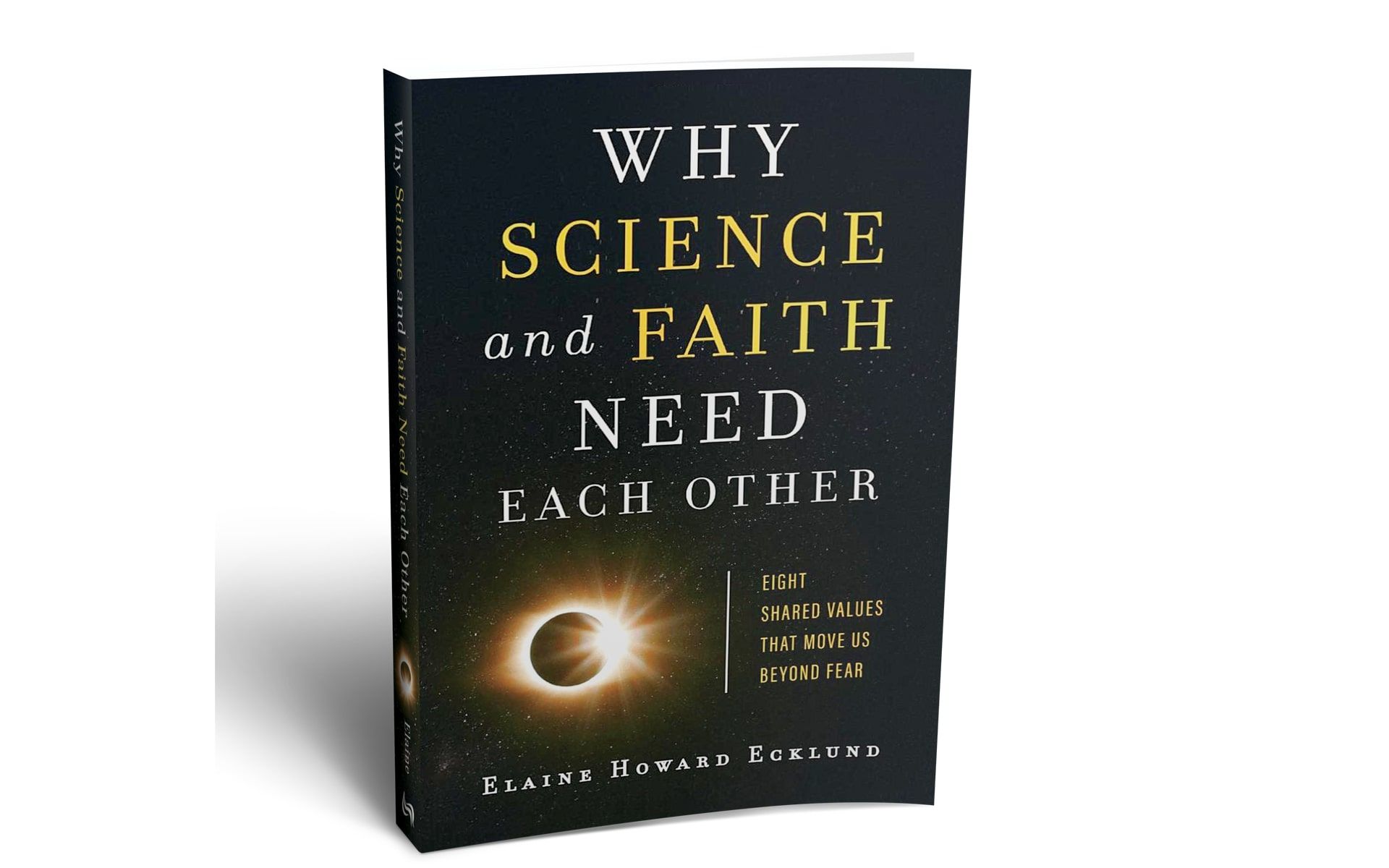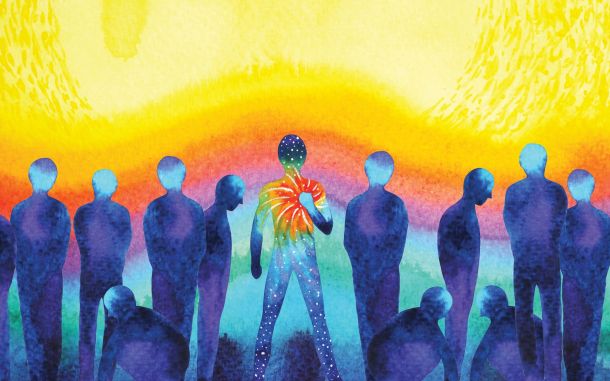8 Shared Values of Science and Faith

In This Article
-
Ecklund believes that atheists and believers can be connected in a multitude of surprising ways across 8 values: curiosity, doubt, humility, creativity, healing, awe, shalom, and gratitude.
-
“Why Science and Faith Need Each Other” is the bridge between two seemingly distant worlds that desperately need one another.
Book Review
Why Science and Faith Need Each Other: Eight Shared Values That Move Us Beyond Fear
By Elaine Howard Ecklund
978-1587434365
Brazos Press, May 2020
pp. 176
“70 percent of [these] scientists (who work as engineers or in research and development) said that the narrative that all life, including humans, evolved over millions of years without the involvement of God or an intelligent force was probably or definitely false.” (p. 42)
It is sometimes asserted that religion is the stuff of miracles, blind faith, and obedience while science is based upon facts, logic, and sound reasoning. This paints an image of a great rift between two incompatible forces that are perpetually at odds with one another. Dr. Elaine Howard Ecklund works to dispel this narrative in her book “Why Science and Faith Need Each Other: Eight Shared Values That Move Us Beyond Fear” by examining what the two disciplines have in common within the context of Christianity and its greater American community. Dr. Ecklund believes that atheists and believers can be connected in a multitude of surprising ways across 8 values: curiosity, doubt, humility, creativity, healing, awe, shalom, and gratitude. There are only a few passing references to these values in this review; readers should take a look into the book for a more comprehensive discussion.
This book is primarily targeted towards Christian audiences as a guide for how to better inculcate an appreciation, acceptance, and love of science in their churches. However, it is also informative for members of other faith traditions that wish to better understand how science can relate to their faith, and how to better discuss science in religious settings. Curious atheists and agnostics that believe science and faith are incompatible can also benefit from hearing Ecklund’s arguments, as they often come from scientific and empathetic approaches that they may more strongly relate to than strictly theological ones.
Science and faith are compatible
Ecklund is a devout Christian who firmly believes that science and religion are as compatible as can be. A sociologist by education, she has travelled across the world interviewing Christian scientists and churchgoers, along with members of other faith traditions, about how, or even if, science and religion co-exist. “Why Science and Faith Need Each Other” is the culmination of her research: it is an informative and eye-opening, yet enjoyable and easy to read, look into science’s place in Christianity.
One of Ecklund’s key takeaways is that a majority of Christian scientists and churchgoers that she interviewed believed that science and religion were compatible but that they did not feel comfortable, or invited, to talk about the relation of science and religion openly in religious settings. This has led to the perpetuation of a stigma that Christians, especially more evangelical ones, are against science and that they believe it has no place in church settings. One of Ecklund’s primary goals is to dispel this stigma by showing how open the Christian community actually is to discussing science’s place in religion and by proving, through the arguments of Christian scientists, that religion and science are indeed compatible. She also indirectly aims to advise readers with steps that they utilize to better incorporate religion into science, and vice versa, in both their daily lives and religious environments.
Science’s place in Christianity
Science often has the capacity to leave those that study it closely in complete awe of it. Religious communities use science as a vehicle to better understand and observe the power and wisdom of God. Exceptionally complex microbes and cells often leave Christian scientists dazzled at the might of the One capable of creating such awe-inspiring creations. Non-believing scientists also tend to experience a similar form of awe from their research, though the focus is more so on the complexity and orderliness of creation as opposed to the might of the Creator behind it. Ecklund points out similarities such as this in order to show that Christians, scientists, and believers have more in common with each other than they may think.
Evolution and Darwinism are much discussed in the book, as they have been important sources of discussion for Christian communities for the past 100+ years. Darwinism, and sometimes science in general, has often been viewed as a source of doubt and insecurity. It was thus feared that this doubt could undermine a person’s faith and therefore it has sometimes been discouraged to bring up such topics in church. Doubting is also a natural part of the scientific process, as many curious questions around science begin by doubting a status quo. Ecklund believes that this fear of doubt in churches is dangerous as it only stifles the mind. She argues that churches, instead of fearing doubt and running from it, should confront doubts raised by science head-on. She narrates how her own faith was strengthened and became resilient through overcoming doubts that she personally had.
Humility is touched upon as an absolute necessity for religious communities that wish to confront, and perhaps come to terms with, science and viewpoints that may contradict their beliefs. Ecklund argues that it requires humility to take a step back and realize that one’s previous assumptions were incorrect whether they are believers or not. She cites some of humanity’s greatest modern scientists, such as Albert Einstein, and the humility that they presented and how it allowed them to achieve the success that they did as scientists. Humility also allows both sides to consider that, perhaps, there is something going on behind the scenes of life and that they can benefit from one another as opposed to existing in a constant state of disagreement, animosity, and argument.
Religious settings should foster scientific discussions
Ecklund argues that churches should be less fearful of having discussions around topics that are considered taboo. This specifically includes infertility. She narrates how important the concept of having children is in Christian societies and how women, even established scientists, are often seen first and foremost as mothers and caretakers within church settings. This can present obvious difficulties for couples that are struggling with infertility. Ecklund goes into detail discussing her own personal struggles with infertility and the lack of open discussion in many churches around topics such as this one. She calls on church leaders to be more mindful of the real-life problems that their congregants may be facing and encourages them to create environments where they can feel open and encouraged to discuss the difficulties that they may be wrestling with. Leaders of any spiritual setting can heed her advice as it is important for believers to constantly be discussing the difficulties that their followers are facing.
Ecklund also touches upon the importance of curiosity, how churches are stifling it, and why they need to be more open when it comes to letting people explore their natural curiosity. Curiosity is the itch in our brains and hearts that motivates us to find answers or to discover the truth. When restricted, it can cause discomfort or frustration, as was the case with Jill, a scientist that Ecklund had interviewed. As a teenager in her church, Jill was curious about the role of science in Christianity, however her pastor told her to “…make a decision to believe…to forget about science” (p. 59). Her curiosity was continuously stifled over and over, thus leading her to believe that religion was a tool for passing judgment onto others. Ecklund encourages churches to allow their congregants to explore their curiosities by discussing their questions because, she argues, these discussions can lead to a stronger conviction in their faith. The same can be said for members of other religions if faith is being used to smother curiosity and instead enforce control.
The latter part of the book focuses on redemption and encourages Christians to accept and utilize science in order to alleviate the suffering of others. Ecklund highlights statistics that show that an overwhelming majority of members of both the scientific and religious communities place a high emphasis on alleviating the suffering of others. She also discusses how Christians view medicine as a gift from God onto mankind as a means to end suffering, and that the knowledge itself that scientists and doctors must possess in order to enhance and utilize medicine is also a divine gift. This idea runs parallel to the core tenets of Islam, where knowledge is also described as a gift from God, and serves as another solid example of how non-Christians can gain insight from this book.
Many of the theological topics discussed in the book, such as evolution, embryonic freezing, genetic modifications, and the usage of stem cells are also modern scientific hot topics for other faith groups. These modern issues pose questions for all people across all faiths, thus demanding a discussion. Non-Christians perceive and understand the nuances of their faith from a lens that differs from Christianity’s, but believers can gain a wealth of insight regardless. It addresses the place of God in science, something that all believers can relate to and discuss, within a Christian context.
“Why Science and Faith Need Each Other” is the bridge between two seemingly distant worlds that desperately need one another. It is a love-letter to both of them from a scientist that has spent much of her life reconciling how the two relate, intertwine, and differ. Curious readers of all faiths, or lack thereof, will gain much insight from this thorough and intellectual discussion.









